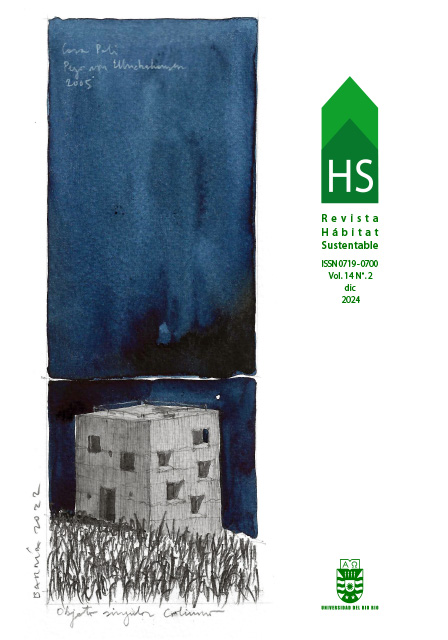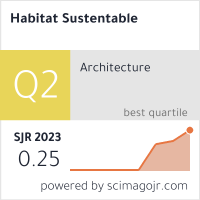Influencia de los parámetros de diseño de protecciones solares en la eficiencia energética en climas áridos templados fríos, Mendoza, Argentina
DOI:
https://doi.org/10.22320/07190700.2024.14.02.10Palabras clave:
protecciones solares, simulación paramétrica, eficiencia energética, clima árido templado fríoResumen
El sector de la construcción tiene un impacto significativo en el consumo energético global y en las emisiones de carbono. A pesar de los avances tecnológicos y de materiales, el rendimiento energético de los edificios depende principalmente de las decisiones de diseño arquitectónico. Este estudio evalúa cómo las configuraciones de sistemas de protección solar afectan los consumos energéticos de calefacción, refrigeración e iluminación en un box de estudio ubicado en un clima árido templado frío. Los resultados muestran que la proporción ventana-pared (WWR) y la orientación absoluta son factores determinantes en el consumo energético. Se observó un incremento del 16% en el consumo de refrigeración y del 13% en iluminación con el aumento progresivo del WWR. Además, la demanda de calefacción aumentó en torno al 18% según la orientación. Estos hallazgos destacan la importancia de ajustar las variables de diseño para optimizar la eficiencia energética de los edificios.
Descargas
Citas
ALANÍS-NAVARRO, J. A., CASARRUBIAS-BAHENA, D., ALANÍS-CANTÚ, R., y LAVÍN-DELGADO, J. E. (2017). Correlación y regresión lineal de variables climatológicas para el diseño de ecotecnologías y arquitectura bioclimática. Revista de Arquitectura y Diseño, 1(2), 1–12. https://www.ecorfan.org/spain/researchjournals/Arquitectura_y_Diseno/vol1num2/Revista_de_Arquitectura_y_Dise%C3%B1o_V1_N2_1.pdf
BETMAN, A., BALTER, J., HONGN, M., y GANEM, C. (2023). Estudio paramétrico de sistemas de parasoles para reducción del consumo energético en climas con alta heliofanía. Avances en Energías Renovables y Medio Ambiente, 27, 45–55. https://portalderevistas.unsa.edu.ar/index.php/averma/article/view/4592
BUSTAMANTE, W., y ENCINAS, F. (2012). Parámetros de diseño y desempeño energético en edificios de clima mediterráneo. ARQ (Santiago), 82, 116–119. https://doi.org/10.4067/S0717-69962012000300020
DABBAGH, M., y KRARTI, M. (2022). Experimental evaluation of the performance for switchable insulated shading systems. Energy and Buildings, 256, 111753. https://doi.org/10.1016/j.enbuild.2021.111753
Dirección Nacional de Escenarios y Planeamiento Energético. (2019). Escenarios Energéticos 2030. Buenos Aires: Secretaría de Energía, Ministerio de Hacienda. http://www.energia.gob.ar/contenidos/archivos/Reorganizacion/planeamiento/2019-11-14_SsPESGE_Documento_Escenarios_Energeticos_2030_ed2019_pub.pdf
DOORNIK, J. A., y HANSEN, H. (2008). An omnibus test for univariate and multivariate normality. Oxford Bulletin of Economics and Statistics, 70(s1), 927–939. https://doi.org/10.1111/j.1468-0084.2008.00537.x
GHOSH, A., y NEOGI, S. (2018). Effect of fenestration geometrical factors on building energy consumption and performance evaluation of a new external solar shading device in warm and humid climatic condition. Solar Energy, 169, 94–104. https://doi.org/10.1016/j.solener.2018.04.025
HENZE, N., y ZIRKLER, B. (1990). A class of invariant consistent tests for multivariate normality. Communications in Statistics - Theory and Methods, 19(10), 3595–3617. https://doi.org/10.1080/03610929008830400
International Energy Agency [IEA]. (2021). Building Envelopes. IEA, Paris. https://www.iea.org/reports/building-envelopes
IPCC. (2023). Statement on the ‘Climate Change 2023: Synthesis Report’, 20 March 2023. https://reliefweb.int/report/world/statement-climate-change-2023-synthesis-report-20-march-2023?gad_source=1
KAASALAINEN, T., MÄKINEN, A., LEHTINEN, T., MOISIO, M., y VINHA, J. (2020). Architectural window design and energy efficiency: Impacts on heating, cooling and lighting needs in Finnish climates. Journal of Building Engineering, 27, 100996. https://doi.org/10.1016/j.jobe.2019.100996
KHIDMAT, R. P., FUKUDA, H., KUSTIANI, y WIBOWO, A. P. (2021). Designing louvers toward optimum daylight performance in Indonesia: a parametric study. IOP Conference Series: Earth and Environmental Science, 907(1), 012012. https://doi.org/10.1088/1755-1315/907/1/012012
KIRIMTAT, A., KOYUNBABA, B. K., CHATZIKONSTANTINOU, I., y SARIYILDIZ, S. (2016). Review of simulation modeling for shading devices in buildings. Renewable and Sustainable Energy Reviews, 53, 23–49. https://doi.org/10.1016/j.rser.2015.08.020
KOÇ, S. G., y MAÇKA KALFA, S. (2021). The effects of shading devices on office building energy performance in Mediterranean climate regions. Journal of Building Engineering, 44, 102653. https://doi.org/10.1016/j.jobe.2021.102653
MANGKUTO, R. A., KOERNIAWAN, M. D., APRILIYANTHI, S. R., LUBIS, I. H., ATTHAILLAH, HENSEN, J. L. M., y PARAMITA, B. (2021). Design Optimisation of Fixed and Adaptive Shading Devices on Four Façade Orientations of a High-Rise Office Building in the Tropics. Buildings, 12(1), 25. https://doi.org/10.3390/buildings12010025
MARDIA, K. V. (1970). Measures of multivariate skewness and kurtosis with applications. Biometrika, 57(3), 519–530. https://doi.org/10.2307/2334770
NAZARI, S., KESHAVARZ MIRZA MOHAMMADI, P., y SAREH, P. (2023). A multi‐objective optimization approach to designing window and shading systems considering building energy consumption and occupant comfort. Engineering Reports, 5(10), 1–39. https://doi.org/10.1002/eng2.12726
Servicio Meteorológico Nacional. (2023). Estado del clima en Argentina 2022. https://repositorio.smn.gob.ar/handle/20.500.12160/2378#:~:text=El%202022%20fue%20levemente%20m%C3%A1s,oto%C3%B1o%20e%20inicio%20del%20invierno.
SPEARMAN, C. (1961). The proof and measurement of association between two things. In J. J. Jenkins & D. G. Paterson (Eds.), Studies in individual differences: The search for intelligence (pp. 45–58). Appleton-Century-Crofts.
ZOU, K. H., TUNCALI, K., y SILVERMAN, S. G. (2003). Correlation and simple linear regression. Radiology, 227(3), 617- 628. https://doi.org/10.1148/radiol.2273011499
Descargas
Publicado
Cómo citar
Número
Sección
Licencia
Derechos de autor 2024 Alicia Betman, Julieta Balter, Stella Maris Donato, Carolina Ganem

Esta obra está bajo una licencia internacional Creative Commons Atribución-CompartirIgual 4.0.
El contenido de los artículos que se publican en cada número de Hábitat Sustentable, es responsabilidad exclusiva de los autores y no representan necesariamente el pensamiento ni comprometen la opinión de la Universidad del Bío-Bío.
Los autores/as conservarán sus derechos de autor y garantizarán a la revista el derecho de primera publicación de su obra, el cuál estará simultáneamente sujeto a la Licencia de Reconocimiento de Creative Commons CC BY-SA que permite a otros compartir-copiar, transformar o crear nuevo material a partir de esta obra con fines no comerciales, siempre y cuando se reconozcan la autoría y la primera publicación en esta revista, y sus nuevas creaciones estén bajo una licencia con los mismos términos.











 Programa de Información Científica/Concurso Fondos de Publicación de Revistas Científicas 2018/ Proyecto Mejoramiento de Visibilidad de Revistas UBB (Código:FP180007)
Programa de Información Científica/Concurso Fondos de Publicación de Revistas Científicas 2018/ Proyecto Mejoramiento de Visibilidad de Revistas UBB (Código:FP180007) 





